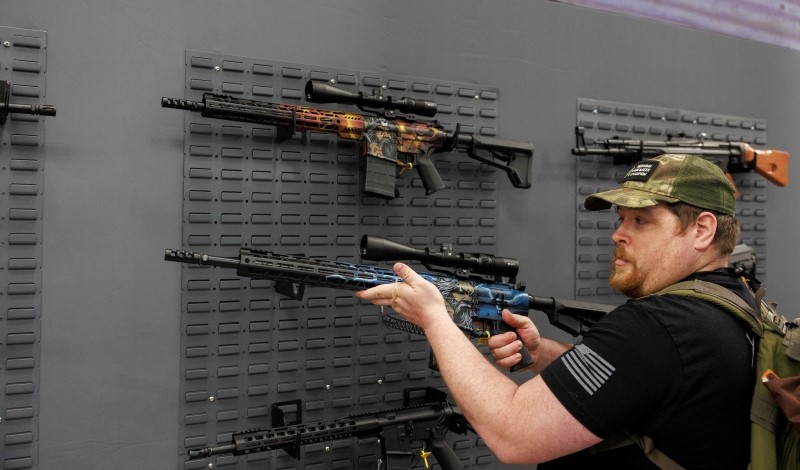
A recent Supreme Court decision affects ATF’s efforts to redefine gun regulations.
In Garland v. Cargill, the Supreme Court held that the Bureau of Alcohol, Tobacco, Firearms, and Explosives (ATF) exceeded its statutory authority when it reclassified bump stocks as machine guns under federal law. The decision does not bode well for the agency’s ongoing defense of other recent and similarly expansive administrative reinterpretations of federal gun regulations. Even as ATF licks its wounds, the beatings are likely to continue.
Cargill centered on one of the most important distinctions drawn by federal gun regulations: between machine guns, the civilian possession of which is heavily restricted, and semiautomatic firearms, which are not singled out by federal law for special restrictions and which for decades have been the type of firearm most commonly possessed by law-abiding civilians.
In layman’s terms, the technical difference between a machine gun and a semiautomatic firearm has long been understood as boiling down to the mechanics of what must happen for the gun to fire a second bullet. In a semiautomatic weapon, engaging the trigger causes the gun to fire exactly one round, regardless of how long the trigger remains engaged. Each subsequent round must be fired by disengaging the trigger so that it resets, then re-engaging the trigger for an additional shot.
In a machine gun, however, once the trigger is engaged, the weapon fires bullets continuously and automatically until either the trigger is disengaged, or the weapon runs out of ammunition. From a practical perspective, then, machine guns typically have a much higher rate of fire than semiautomatic firearms.
When Congress defined “machine gun” in the National Firearms Act of 1934 (NFA), it did so in a manner that captured the technical distinction, rather than any practical differences. The term encompasses “any weapon which shoots, is designed to shoot, or can be readily restored to shoot, automatically more than one shot, without manual reloading, by a single function of the trigger.”
In the late 2000s, however, some manufacturers began selling aftermarket accessories called bump stocks. These bump stocks could be affixed to many commonly owned semiautomatic rifle platforms and they enable the shooter, through a combination of technique and physics, to harness energy from the rifle’s recoil to pull the trigger much more rapidly than most shooters could manage without the device. In essence, bump stocks closed the practical rate-of-fire gap between semiautomatic rifles and machine guns without changing the internal mechanics of how the semiautomatic rifle operated.
Over the course of multiple administrations, ATF consistently took the position that these devices do not turn semiautomatic rifles into machine guns, and the agency therefore lacked authority to regulate them. In reliance on this position, Americans have lawfully purchased an estimated 520,000 bump stocks.
Then, in late 2017, on the heels of a high-profile mass public shooting involving the use of a bump stock, ATF abruptly changed course. Dismissing warnings from former ATF officials, major gun control groups, and politicians that bump stock regulation required legislative action, the agency issued a final rule in which it determined not only that bump stocks did, in fact, turn a semiautomatic rifle into a machine gun, but also that the devices had in essence always been machine guns, despite the agency’s previous determinations to the contrary. Americans who possessed a bump stock were now required to destroy the device or surrender it to ATF, without receiving compensation for their value.
In Cargill, a 6-3 majority of the Supreme Court held that ATF lacked statutory authority to promulgate the rule because a bump stock unambiguously falls outside the existing statutory definition of “machine gun.”
Justice Clarence Thomas’ majority opinion centered the meaning of the phrase “by a single function of the trigger” on the firearm’s internal mechanics, which are unaffected by the addition of a bump stock. The Court reasoned that a semiautomatic rifle equipped with a bump stock is not a machine gun because it still cannot fire more than one shot “by a single function of the trigger,” even if the device reduces the amount of time that elapses between separate “functions” of the trigger.
Even on its own, Cargill spells an ominous sign for ATF in its ongoing battles to defend several other major rule changes against claims under the Administrative Procedure Act. But combined with the Court’s near-simultaneous destruction of Chevron deference in Loper Bright Enterprises v. Raimondo, the decision packs a hefty one-two punch that strips the ATF of an often-relied upon crutch in future litigation.
The Supreme Court has already granted certiorari in Garland v. VanDerStok, which will be heard in the Court’s 2024-2025 term. At issue in VanDerStok is an ATF final rule in which the agency—much as it did with bump stocks—sought to bypass perceived congressional inaction on so-called ghost guns and weapons-parts kits by “updating” its interpretation of what the agency can regulate as a “firearm” under the Gun Control Act of 1968.
As in Cargill, the plaintiffs in VanDerStok do not allege that ATF’s new regulations violate the Second Amendment, but rather they claim that the agency’s new interpretation is unambiguously contrary to federal law. This time, ATF will have to come up with a better textual argument than—to paraphrase Cargill’s dissenting justices—if it “walks like a duck, swims like a duck, and quacks like a duck,” the agency can regulate it like a duck.
There is, perhaps, at least one silver lining for ATF. Ironically, had it been successful, ATF’s administrative reclassification of bump stocks could have had the unintended consequence of undermining the government’s position in future Second Amendment challenges to the National Firearms Act.
When analyzing whether a type of firearm is protected under the Second Amendment, the Court has consistently grounded its analysis in discussions over “common use,” at various times framing the discussion as whether the firearm is “of the kind in common use at the time,” whether it is “dangerous and unusual,” and whether it is of a type “typically possessed by law-abiding citizens for lawful purposes.”
Put simply, numbers seem to matter.
There are far more bump stocks in civilian hands than there are “machine guns,” at least as that term has historically been defined, and even after discounting the acquisitions by individuals holding a Class III “dealer” license as a result of the Firearm Owners Protection Act. Reclassifying these semiautomatic weapons as their fully automatic NFA counterparts significantly inflates their civilian stock, making it much harder for the government to argue that these weapons are not in common use by law-abiding civilians today.
Perhaps ATF should keep that in mind as it defends yet another of its final rules—one that would reclassify millions of brace-equipped pistols as short-barreled rifles.
This essay is part of a series, titled The Supreme Court’s 2023-2024 Regulatory Term.




